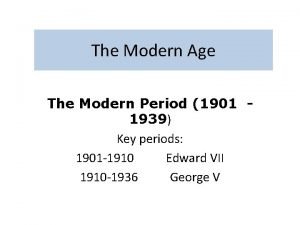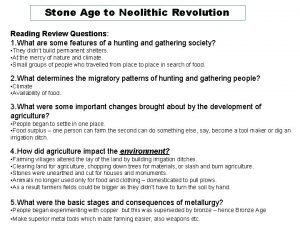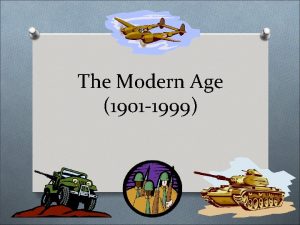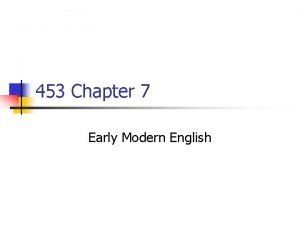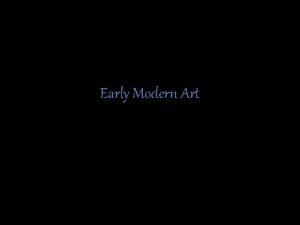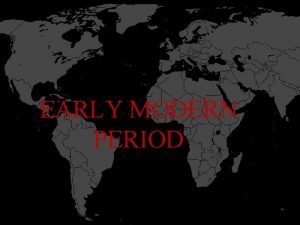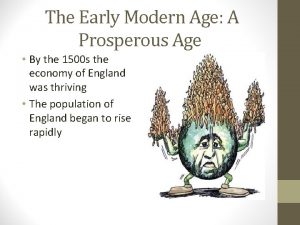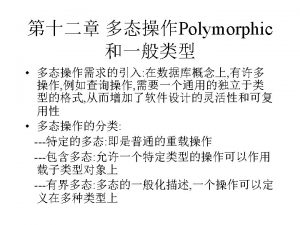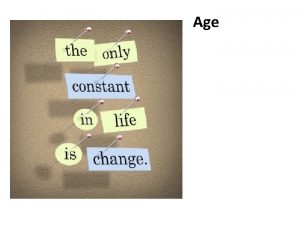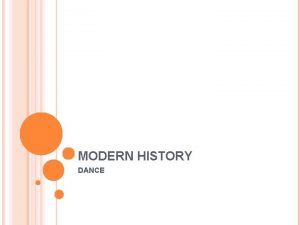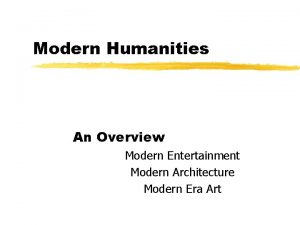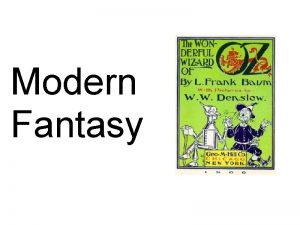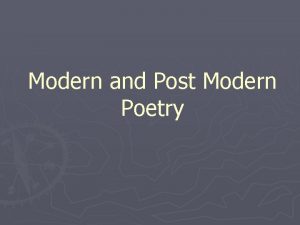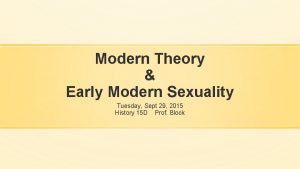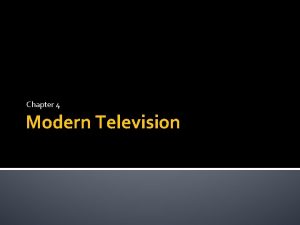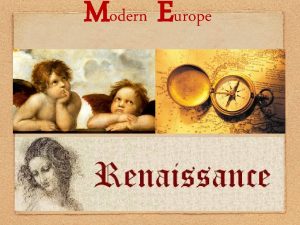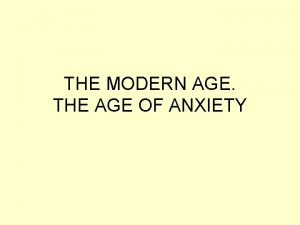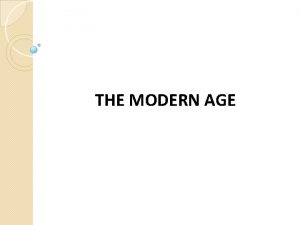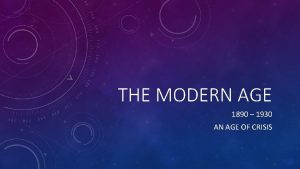EARLY MODERN AGE EARLY MODERN AGE THE AGE





























- Slides: 29

EARLY MODERN AGE

EARLY MODERN AGE THE AGE OF DISCOVERIES THE EARLY MODERN STATE HUMANISM REFORMATION AND COUNTERREFORMATION

1. THE AGE OF DISCOVERIES 1. 2. 3. 4. 5. CAUSES OF DISCOVERIES PRECOLUMBIAN CIVILISATIONS PORTUGUESE DISCOVERIES SPANISH DISCOVERIES CONSEQUENCES

1. 1. CAUSES POLITICAL: The fall of the Byzantine Empire in 1453 made the Turks the rulers of East Mediterranean Sea and blocked European trade from Asia. The end of the Reconquest: soldiers looked for more lands to conquer.

1. 1. CAUSES ECONOMIC East products were highly demanded in Europe: spices or luxury products. SCIENTIFIC: Many scientits based on Ptolemy defend the Earth was spherical, so it was possible to reach Indian travelling to the west.


1. 1. CAUSES TECHNICAL Sailors used compass, sextant and astrolabe to help them across the sea. New ships were built such as caravel.

1. 2. PRE-COLUMBIAN CIVILISATIONS MAYAS Was located at Yucatan Peninsula Splendour had finished in th 13 th century. They were organised in many city-states. Great advances: astronomy and pharmaceutic.


1. 2. PRE-COLUMBIAN CIVILISATIONS AZTECS Grew in the center and south of Mexico in the 15 th century. The capital was Tenochtitlan The society was ruled by the emperor (last one was Moctezuma) Great advances: astronomy and maths.


TENOCHTITLAN

1. 2. PRE-COLUMBIAN CIVILISATIONS INCAS Located in present-day Peru, Bolivia and Ecuador, it grew in the 15 th century. Empire hierarchical and ruled by the emperor (last one: Atahualpa) Their language was called Quechua.


swf

1. 3. PORTUGUESE DISCOVERIES HENRY THE NAVIGATOR promoted a school to encourage sailing methods. The objective of Portuguese was to reach India surrounding Africa. Different stages: MADERIRA, AZORES AND CABO VERDE (from 1418 to 50 s) GULF OF GUINEA (70 s) BARTOLOMEU DIAS rounded the CAPE OF GOOD HOPE. VASCO DE GAMA arrived CALICUT (India) in 1497.


1. 4. SPANISH: CASTILE ENRIQUE III and ISABEL commanded conquest of Canary Island, from 1402 to 1496. The Castilian conquest caused some conflict with Portugal. They signed the Treaty of Alcaçovas (1479), because of it the Spanish explorations should go towards the Atlantic Ocean.


CHRISTOPHER COLUMBUS He thought that the Earth was a sphere and there was a route to reach China throught out the west. He needed money so he asked to Portugal, but thee king did not accept. He met the Catholic Monarch and signed CAPITULATIONS OF SANTA FE (april 1492): Columbus would become Admiral of the Ocean and Governor-General of the discovered lands. The territories would be under Castile´s sovereignity.

COLUMBUS VOYAGES FIRST VOYAGE (August 1492 to march 1493): He departed from Palos de la Frontera with Pinta, Niña and Santa María. 12 th october 1492 arrived to San Salvador. He thought he had arrived to India, he called Indias. They discovered Cuba (Juana) and San Salvador (La Española).

COLUMBUS VOYAGES SECOND VOYAGE (september 1493 to june 1496): He departed from Cadiz with 17 ships. Explored Caribbean islands: Puerto Rico, Martinica, etc. THIRD VOYAGE (may 1498 to november 1500) First time he explored American continent FOURTH VOYAGE (may 1502 to november

swf

COLUMBUS VOYAGES Columbus´discoveries caused discussions with Portugal. Spain and Portugal signed the Treaty of Tordesillas (1494) fixing a line that divided the conquests.

AFTER COLUMBUS VASCO NUÑEZ DE BALBOA discovered the Pacific Ocean in the Isthmus of Panama (1513) FERNANDO DE MAGALLANES and JUAN SEBASTIAN ELCANO completed the first circunmnavigation of the Earth. Magallanes died in Philippines (1521), one year later Elcano arrived to Sevilla.

Swf

1. 5. CONSEQUENCES SOCIAL: Mortal rate rose among nativ popuation due to the wars and diseases like smallpox. Black people were taken from Africa to America as slaves. Mixed population: MESTIZOS: white people and Indians MULATOS: white and black ZAMBOS: black people and Indians.

1. 5. CONSEQUENCES ECONOMIC: New crops arrived to Europe: potato, maize, tomato, etc. New cattle were introduce into America: pig, cow or horse. New trade rutes were created. POLITICAL: 2 great colonial empires were born: Spanish and Portugese.

 Victorian age and modern age
Victorian age and modern age Difference between stone age and modern age
Difference between stone age and modern age Iron age dates
Iron age dates Iron age bronze age stone age timeline
Iron age bronze age stone age timeline Early cpr and early defibrillation can: *
Early cpr and early defibrillation can: * Tư thế ngồi viết
Tư thế ngồi viết Ví dụ giọng cùng tên
Ví dụ giọng cùng tên Voi kéo gỗ như thế nào
Voi kéo gỗ như thế nào Thẻ vin
Thẻ vin Thể thơ truyền thống
Thể thơ truyền thống Hươu thường đẻ mỗi lứa mấy con
Hươu thường đẻ mỗi lứa mấy con Từ ngữ thể hiện lòng nhân hậu
Từ ngữ thể hiện lòng nhân hậu Thế nào là hệ số cao nhất
Thế nào là hệ số cao nhất Diễn thế sinh thái là
Diễn thế sinh thái là Vẽ hình chiếu vuông góc của vật thể sau
Vẽ hình chiếu vuông góc của vật thể sau Phép trừ bù
Phép trừ bù Lời thề hippocrates
Lời thề hippocrates đại từ thay thế
đại từ thay thế Vẽ hình chiếu đứng bằng cạnh của vật thể
Vẽ hình chiếu đứng bằng cạnh của vật thể Chụp phim tư thế worms-breton
Chụp phim tư thế worms-breton Quá trình desamine hóa có thể tạo ra
Quá trình desamine hóa có thể tạo ra Công thức tính độ biến thiên đông lượng
Công thức tính độ biến thiên đông lượng Thế nào là mạng điện lắp đặt kiểu nổi
Thế nào là mạng điện lắp đặt kiểu nổi Sự nuôi và dạy con của hổ
Sự nuôi và dạy con của hổ Các châu lục và đại dương trên thế giới
Các châu lục và đại dương trên thế giới Dạng đột biến một nhiễm là
Dạng đột biến một nhiễm là Nguyên nhân của sự mỏi cơ sinh 8
Nguyên nhân của sự mỏi cơ sinh 8 Bổ thể
Bổ thể Phản ứng thế ankan
Phản ứng thế ankan
